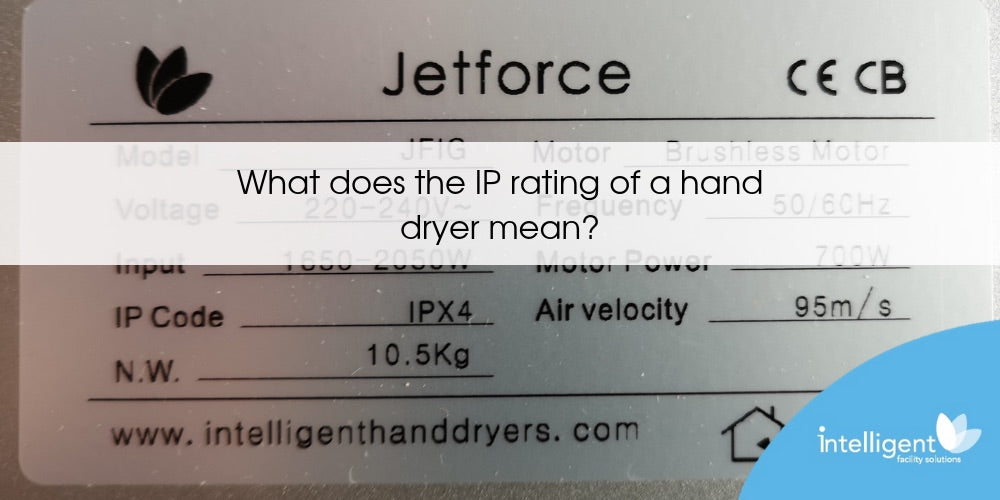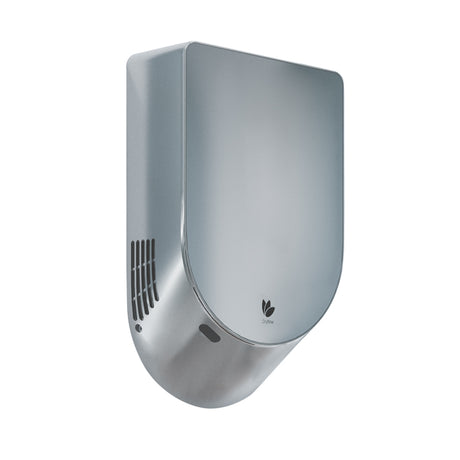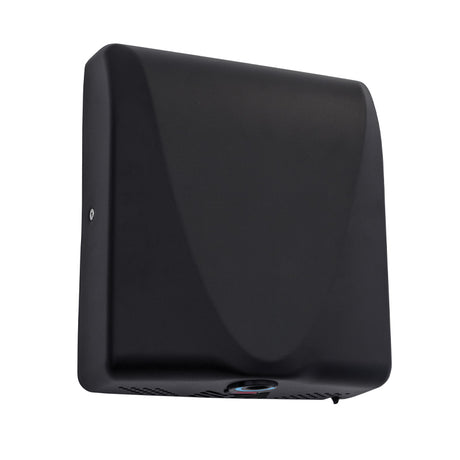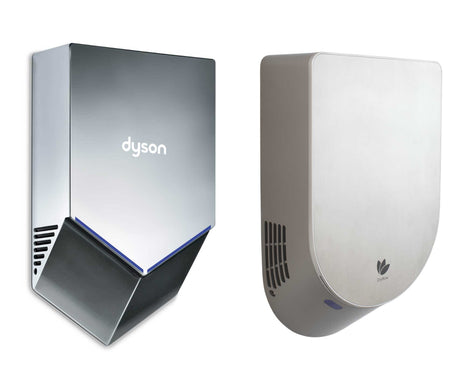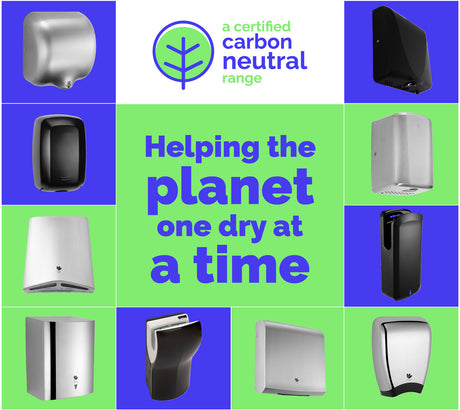In simple terms, hand dryers need to be fitted at a safe distance from water supplies and this distance depends on the IP rating of the hand dryer.
If you want to know “where can you safely install a hand dryer in a washroom?” then this post is for you.
IP is the abbreviation for Ingress Protection, and is outlined under the standard EN60529. This is an international classification system for the sealing effectiveness of enclosures of electrical equipment such as hand dryers, against entry of foreign bodies such as dust, tools, fingers and moisture. The classification will be shown using IP followed by two, or occasionally three further numbers; these numbers represent the level of protection the appliance provides. The higher the number, the greater the protection.
First Number

- The level that persons are protected against contact with moving parts that could prove hazardous
- The level of protection against solid objects entering the mechanics of the unit.
Second Number
- The level of protection against liquids entering the electrical unit
For hand dryers in a washroom, the second number is most relevant, as it indicates the degree of protection against potentially dangerous moisture.
| IP Rating | |
| First Digit | |
| 0 | No special protection |
| 1 | Protection from a large part of the body such as the hand, from solid objects greater than 50mm in diameter |
| 2 | Protection against fingers or other object not greater that 80mm in length and 12mm in diameter |
| 3 | Protection from entry by tools, wires, etc with a diameter or thickness greater than 1mm |
| 4 | Protection from entry by solid objects with a diameter or thickness greater than 1mm |
| 5 | Protection from the amount of dust that would interfere with the operation of equipment |
| 6 | Dust tight |
| Second Digit | |
| 0 | No special protection |
| 1 | Protection from dripping water |
| 2 | Protection from vertically dripping water |
| 3 | Protection from sprayed water |
| 4 | Protection from splashed water |
| 5 | Protection from water projected from a nozzle |
| 6 | Protection against heavy seas, or powerful jets of water |
| 7 | Protection against immersion |
| 8 | Protection against complete, continuous submersion |
So for example, the Dyson Airblade AB14 hand dryer has an IP rating of IP35. The first number, 3, means that the AB14 is protected from entry by tools, wires, etc. The second number, 5, indicates that the Dyson Airblade is protected against water projected from a nozzle.
If after the IP, the first number is X, for example IPX5 it means the dryer has not been tested against the first number classification; hand dryers are not required to.
Washroom and Bathroom Zones
Most washrooms, where hand dryers are going to be installed, will only have sinks as a source of water. Hand dryers are also becoming a popular addition to the home
Installation of a hand dryer around a sink needs to be located at a 0.6m radius away from any tap, which is classed as Zone 2. Hand dryers located in Zone 2 should be a minimum of IPX4 extending to a minimum of IPX5 if the equipment is exposed to cleaning jets.

Outside of Zone 2 the general rules of the Standard apply, but in reality virtually any equipment can now be installed outside Zone 2.”
(Locke, D (2008); Guide to the Wiring Regulations: 17th Edition IEE Wiring Regulations (BS 7671: 2008; p226; Wiley)
Therefore any hand dryer can be located outside of Zone 2 for a sink, as long as it complies with the following standards regarding bathrooms with baths or showers.
Since publishing this post, we have written more about placing hand dryers over a sink and over the sink hand dryers.
Washrooms with Baths and Showers
There will be instances where showers and baths can be present such as changing rooms in leisure centres. The 17th Edition of the IEE Wiring Regulations now considers a room containing a bath or shower to be a special location due to the increased risk of electric shock.
“The zones provide a means of controlling the location type and environmental rating of electrical equipment installed in a bathroom. They are only a guide and, regardless of this, the installation must be properly designed to take into account all foreseen risks in the design of a bathroom within a particular building.”
(Locke, D (2008); Guide to the Wiring Regulations: 17 th Edition IEE Wiring Regulations (BS 7671: 2008; p222; Wiley)
The bathroom has been split into Zones 0, 1 and 2.

- Zone 0 is inside the bath or shower itself. Equipment in Zone 0 should be a minimum of IPX7, which means it has protection against immersion. In Zone 0, no switchgear or accessories are allowed and only a 12V current-using equipment complying with a relevant Standard is allowed.
- Zone 1 can be considered to be the area above the bath or the area where shower water is likely to be directly sprayed. This area is above the bath, 2.25m from the floor. Equipment in Zone 1 should be a minimum of IPX4, extending to a minimum of IPX5 if the equipment is exposed to cleaning jets. In Zone 1 only 12V Separated extra low voltage (SELV) switchgear or accessories allowed.
- Zone 2 is the area beyond Zone 1, extending by a further 0.6m, to a height of 2.25m from the floor. Equipment in Zone 2 should be a minimum of IPX4 extending to a minimum of IPX5 if the equipment is exposed to cleaning jets.
“There are only regulations for Zones 1 and 2. Outside of Zone 2 the general rules of the Standard apply, but in reality virtually any equipment can now be installed outside Zone 2.”
(Locke, D (2008); Guide to the Wiring Regulations : 17th Edition IEE Wiring Regulations (BS 7671: 2008; p226; Wiley)
If you are unsure about where to site your hand dryer, feel free to contact intelligent hand dryers through our website
Give us a call
For more information please call us UK offices: North: 0114 3540047 South: 0203 3270448; Eire office: +353 19036387, use our contact us or click to visit the website .
In the trade? Don’t forget we can set you up with a trade account for your purchases.
We have wholesaler, contractor, public sector and charity discounts available, please don’t hesitate to for more information.
If you have not purchased a hand dryer yet you may find these guides useful:
- Which is the best hand dryer?
- Top 10 Quietest Hand Dryers
- Top High Speed, Quick Drying Hand Dryers
- Best Hand Dryers for Universities
